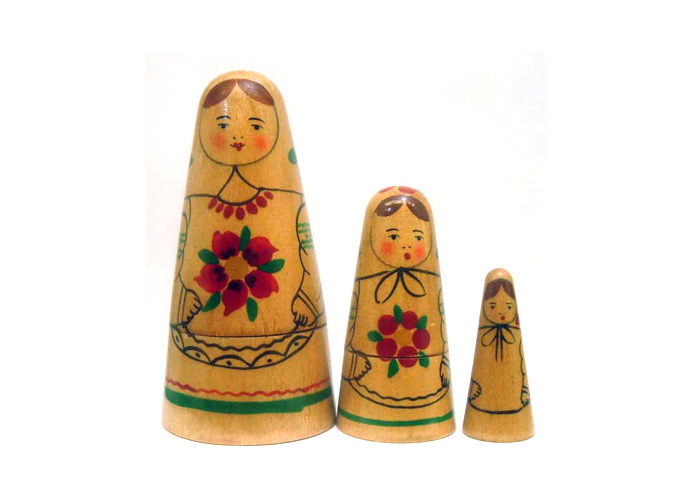More About the History of Handicrafts in Russia
Posted by Maison Russe on Apr 14th 2022
Naro-Fominsk (Наро-Фоминск) is a town in the Moscow region of Russia. It became a town in 1926 after the merger of three villages: Fominskoe, Nara and Malkovo. Historically, the town has ties to the Podolsk municipal district, the city of Podolsk and the Podolsk Urban Okrug. Naro-Fominsk also is associated with the village of Babenskaya. All are in the southwest Moscow region.
From the 19th century onwards, a large number of wood turners were employed in the production of toys. Vasily Petrovich Zvezdochkin, one of the creators of the matryoshka doll, was from the Podolsk province. According to a survey carried out by the Moscow Zemstvo in 1878, the earliest production of turning toys in the Podolsk district is associated with the peasants of the village of Golokhvastovo Motornov. By 1900, the toy trade and sundry assortments covered more than 30 settlements in which about 350 turners operated. The Babenskaya Artel (aka "Babenskoe storage and consumption society of handicraftsmen of turning production") goes back to 1911. It employed hundreds of local artisans who specialized in the art of traditional lathe-polished toy manufacture. The society was founded by 29 peasant turners. Simultaneously, its production of blank matryoshka dolls greatly increased. The local handicraft museum sold the greater portion of all the toys made in the above mentioned "warehouse and consumer society of the Babenskaya artel".
By 1914, about 1000 turners were engaged in the toy trade in more than 40 villages of the Voronovskaya and Krasno-Pakhora volosts (traditional administrative subdivision) of the Podolsk district and the Rudnevskaya volost of the Vereisky district. Needless to say, 1917-1922 was a difficult time for everyone in Russia. After a decree in 1919 - "On Measures to Promote the Handicraft Industry", these "turning artels" began appearing in many areas of the Moscow region. Similar to Babenskaya, Osorginskaya, Likinskaya, "Aprelevskiy Turner", Ulitinskaya "Selchanin", Sergiev Posadskaya "Dityashko" and others were established. In 1924, full-scale electrification came bringing light to the villages. A couple of years earlier, in 1922, the economic policy known as "NEP" (Новая экономическая политика (НЭП), allowed state enterprises to operate on a "for-profit basis". Both of these developments were huge influences. NEP gave the turners freedom to personally go to any available market and negotiate directly with shops, and their owners and buyers. Turners could also hire apprentices, and could work for export (and the "hard" currency that came with it) via state-supplied orders. And also, since the "profits" really didn't amount to all that much, glory came for the handicrafts people who participated in the numerous exhibitions thoughout the world, and who won similarly numerous awards, medals and prizes. Toys were necessary for pre-school education, which had also expanded.
By the mid-1930s, there were three toy factories - Babenskaya, Svitinskaya, and Voronovskaya. Two eventually closed, leaving "Polished Toy" in Babensky. Also, during the years 1939-1945, the entire male population under the age of sixty was drafted into the army, leaving only women to work in the lathe artels. But it wasn't toys that they made, it was war necessities. In the post-WWII period, the production of toys was concentrated in the Babenskaya artel. Because of the reduction in numbers of skilled turners, in turn due to collectivization and the draw to factory work, the quality and assortment of toys narrowed by 80% (from 250 to 50). In the mid-1950s, vocational schools began sending their graduates to the artel. New toys were created, or were re-introduced from earlier forms. But the styles turned "severe", as unpretentious decorative elements began to dominate aesthetics. Raw materials, such as linden, were purchased in the Ryazan and Arzamas regions, and later from Bashkiria. Birch was cut in the Serpukhov forestry.
In 1963, the production of products by pyrography (i.e, "burning out") was organized and machines were modernized. Work from home became almost wholly "work from factory". In 1968, the Babensky factory became the Naro-Fominsk toy factory, and, according to some, Babensky completely lost control of its characteristic qualities, and significantly deteriorated. Shortly afterwards, in 1972, the Babensky workshop was transferred to the Podolsk wooden toy factory (KLIMO), which also hampered further continued success. In the 1970, production included large matryoshka dolls, items for the home, such as jars and barrels, and decorated dolls which could hold a bottle. In the 1980s, decorated metal samovars, conical nesting dolls, children's utensils, mushrooms, and eggs were painted. Some of the products were made with Moscow "80" Olympic decorations on them.
Starting in the early 1960s, tourism had significantly grown, and, over time, business increased. By the 1990s, costs and prices had risen dramatically. Factory prices didn't align with those, colloquiolly speaking, were "behind the fence", the latter being up to 600% higher (for example, from 8 kopeks to 50). And some output, such as the highly popular matryoshka dolls, also were "left to the side". The West was showing great interest in handicrafts, and in the "originality of Russian peasant creativity." This element raged for several years until the demand for turning products fell, the buyers became fewer and craftspeople fled from factories, which then closed. Fewer and fewer professionals could pass on their knowledge of the art to a younger generation. By the mid-1990s, there was only one section in the Moscow Central Children's World with domestic toys. Today, the Babenskaya Toy Education Center can be found in Babinki representing the oldest toy industry in the Moscow region. Showing some promise, the center runs master classes and is followed by true believers. It is a popular spot for an excursion or a school field trip.
Addendum: as a side issue, we've recently began noting the existence of the "Matryoshka Doll Effect". It can be found, for example, in fluid dynamics, family psychology study of cascading issues or effects, "superpowers", organizing skills, etc. The humble nesting doll, indeed!
This is a history inspired by our previous blog: https://therussianshop.com/blog/babenskaya-matryo... Check it out.

